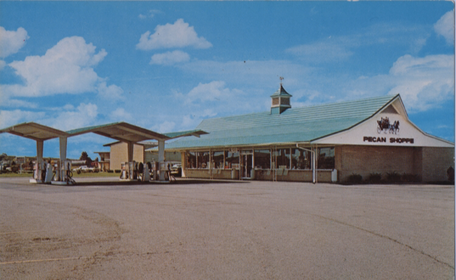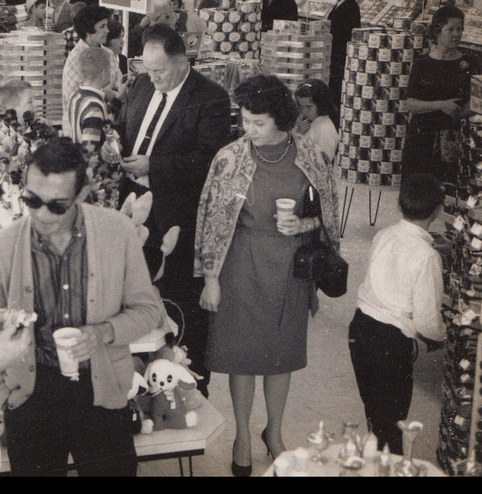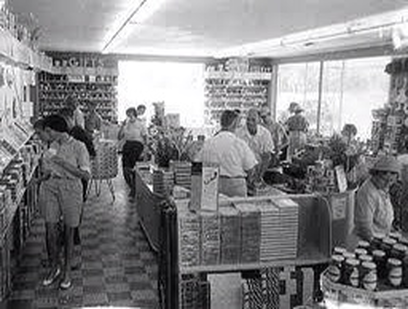 The World Famous Teal Roof The World Famous Teal Roof Sam Burnham, Curator If you’re of a certain age and spent any time at all traveling when you were young, you’ve seen that teal blue roof, those angled covers above the gas pumps, that trade mark red script against a school-bus-yellow sign. I know that on the Coastal plains of Georgia and Florida, you could see a Stuckey’s from at least a mile away. Billboards up and down I-75 announced pecan log rolls, souvenirs, food, gas, and more. Stuckey’s is one of the great stories from the American South. The story begins like the best Southern stories. W.S. Stuckey, Sr. was born on Dodge County farm in 1909. He was just getting his start in adulthood when the Great Depression hit and the bottom fell out of the cotton prices. So in 1931 Stuckey left UGA, right in the middle of his third year of law school to do what he could to help keep his family’s farm going. With food scarce, Stuckey often had to hoist his starving mules back to their feet to plow the fields. There were too few jobs and times were tough. But middle Georgia had an ace in the hole. There was an indigenous crop that was mostly untapped. It was a sleeping giant waiting to be awakened. Pecans. Stuckey begged a local fertilizer dealer for a job doing anything. He was hired to go out and buy pecans. So with $35 borrowed from his grandmother, every dime she had, he set out in a Ford Model A coupe which was unreliable at best. He traveled the countryside John King, a black man who worked on the family farm. On many nights Stuckey and King were so exhausted from work that they slept soundly on the pecan bags. King would eventually own his own Stuckey’s store. From his pecan sales he started his own pecan wholesale business. He bought a pickup truck and started buying his own pecans to sell for processing His philosophy was simple: “You’ve got to be honest with the public. And you’ve got to work. Of course good luck won’t hurt.” It was a philosophy that worked.  "Every Traveler is a Friend" "Every Traveler is a Friend" In 1937, Stuckey decided to make the most of the winter lull. He used some of his pecan sales profits and open a roadside tourist stand. In this lean-to shack he sold pecans, cane juice, homemade quilts, syrup, cane juice, and cherry cider - all you can drink for a nickel. A Texas housewife once told him “You must be crazy building a candy store in a cotton patch 10 miles from a dried-up town.” The idea hits him. He decided to start a candy store. He busted up in the middle of his wife Ethel’s bridge game and asked her to whip up a batch of pralines...something she had never done before. Inexperience was no deterrent. You can’t sell pralines you don’t have. so Ethel and her sisters Hazel and Pearl worked some magic. Soon they’re turning out candy four times a day in their home kitchen and would walk it 2-3 miles out to the roadside stand where Stuckey had signs posted for marketing and selling the fresh goods. “CANDY MADE FRESH TODAY.” Once Stuckey made enough to open his first real store in Eastman he sold his roadside shack to a farmer and the first ever Stuckey’s became a hen house. Humble beginnings. The company thrives on the concept that “every traveler is a friend.” During the post World War II economic boom, travel became a big part of American culture. Stuckey’s strategically placed their stores along US highways 17, 301, and 1. These were main arteries for the annual snowbird migration. And northerners headed for Florida they were met by those famous teal sloped roofs. Marketing brought them in. Southern hospitality brought them back. We’ve already mentioned that John King came to own his own Stuckey’s store. During segregation Stuckey’s was listed in the now historic “Green Book.” The stores were listed in the publication informing black travelers that they were welcome at Stuckey’s for food, gas, and other road trip necessities. While many locations chose to turn black customers away, Stuckey’s welcomed them.  Stuckey's, Circa 1950 Stuckey's, Circa 1950 So the company was on the cutting edge socially. But W.S. Stuckey was also a pioneer in the use of data. He did his own traffic studies on the highways observing the amount of local and out of town travelers. He would drink several cups of coffee and then drive until he needed to make a pit stop. That’s where he would build the next store. Everything from the slope of the roof to which side of the road the store was built on was determined with marketing in mind. He had a plan for everything. His planning was so effective that in less than 20 years, the company had expanded from a lean-to shed in a cotton field to 29 modern stores. The company’s influence began the spread out further and further from Eastman.Stuckey believed in people. He rewarded executives and employees with interest in stores rather than raises. They built stock in the company that way. For example, a secretary making $75 a week would gross $16,000 a year due to her interest in the company. His business model was brilliant: “taking a bunch of good country boys and training them, giving them interest in the store, and having them do the finest job you’ve ever seen.” By 1960 the company based in Eastman, Georgia had 160 stores. Only 10 of those were company owned. Franchisees pulled the wagon and Stuckey saw to it they were looked after. And that is how a man started with a shed in a cotton field and used some innovation and some good old fashioned Southern hospitality to build a roadside mainstay. I won’t steal all of present CEO Stephanie Stuckey’s thunder. She has done extensive research into her family’s business, her heritage, and was kind enough to share some notes from a book she hopes to publish. Perhaps we’ll do a review of it when the time comes. What I’ll definitely do is discuss her new role and the company’s future in the second part of this story. Until then...
2 Comments
James
9/20/2020 07:08:18 pm
Great post! Stuckeys were always a rest stop for my family when we were traveling. I made a rule that we had to stop at every Stuckeys, but my Dad over-ruled me on that one. But we stopped at several each trip.
Reply
Dilowe Barker
9/23/2020 08:16:41 pm
I love the story and just how close it relates to every vacation trip and family reunion That took us by a Stuckey’s we were strategic with 5 kids someone always need to stop to pee as soon as we saw a billboard. Also my grandpa and grannie had two week vacations off work. There were 10 grandkids. They divided one week for each groups of 5. Of course camping KOA destinations and always the nearest Stuckey’s was a highlight.
Reply
Leave a Reply. |
Sam B.Historian, self-proclaimed gentleman, agrarian-at-heart, & curator extraordinaire Social MediaCategories
All
Archives
November 2022
|





 RSS Feed
RSS Feed
